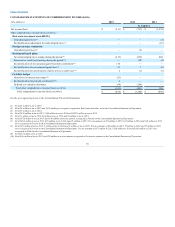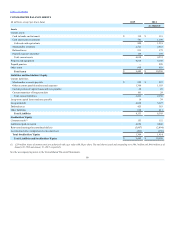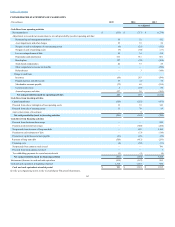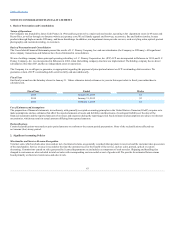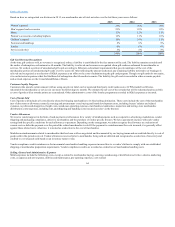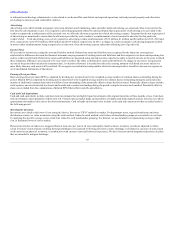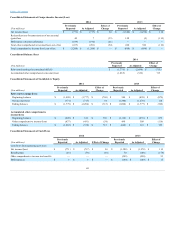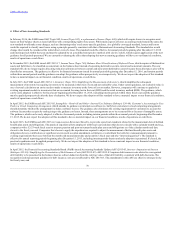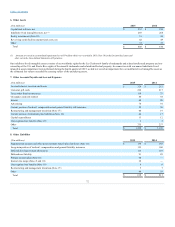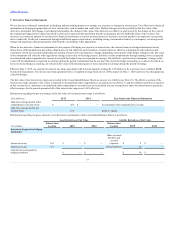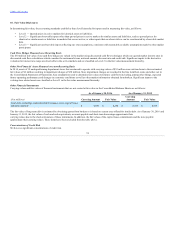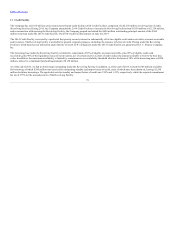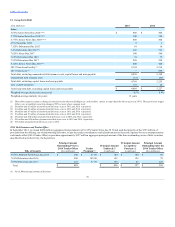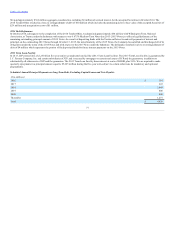JCPenney 2015 Annual Report Download - page 67
Download and view the complete annual report
Please find page 67 of the 2015 JCPenney annual report below. You can navigate through the pages in the report by either clicking on the pages listed below, or by using the keyword search tool below to find specific information within the annual report.
Table of Contents
We use a consistent lease term when calculating amortization of leasehold improvements, determining straight-line rent expense and determining
classification of leases as either operating or capital. For purposes of recognizing incentives, premiums, rent holidays and minimum rental expenses on a
straight-line basis over the terms of the leases, we use the date of initial possession to begin amortization, which is generally when we take control of the
property. Renewal options determined to be reasonably assured are also included in the lease term. Some leases require additional payments based on sales
and are recorded in rent expense when the contingent rent is probable.
Some of our lease agreements contain developer/tenant allowances. Upon receipt of such allowances, we record a deferred rent liability in other liabilities on
the Consolidated Balance Sheets. The allowances are then amortized on a straight-line basis over the remaining terms of the corresponding leases as a
reduction of rent expense.
Costs associated with exit or disposal activities are recorded at their fair values when a liability has been incurred. Reserves for operating leases are
established at the time of closure for the present value of any remaining operating lease obligations (PVOL), net of estimated sublease income. Severance is
recorded over the service period required to be rendered in order to receive the termination benefits or, if employees will not be retained to render future
service, a reserve is established when communication has occurred to the affected employees. Other exit costs are accrued either at the point of decision or the
communication date, depending on the nature of the item.
We recognize the funded status – the difference between the fair value of plan assets and the plan’s benefit obligation – of our defined benefit pension and
postretirement plans directly on the Consolidated Balance Sheet. Each overfunded plan is recognized as an asset and each underfunded plan is recognized as
a liability. We adjust other comprehensive income/(loss) to reflect prior service cost or credits and actuarial gain or loss amounts arising during the period
and reclassification adjustments for amounts being recognized as components of net periodic pension/postretirement cost, net of tax. Prior service cost or
credits are amortized to net income/(loss) over the average remaining service period, a period of about eight years for the primary plan. Pension related
actuarial gains or losses in excess of 10% of the greater of the fair value of plan assets or the plan's projected benefit obligation (the corridor) are recognized
annually in the fourth quarter each year (Mark-to-market (MTM) adjustment), and, if applicable, in any interim period in which an interim remeasurement is
triggered. See Note 3 for the discussion of the accounting change related to our retirement-related benefits.
We measure the plan assets and obligations annually at the adopted measurement date of January 31 to determine pension expense for the subsequent year.
The factors and assumptions affecting the measurement are the characteristics of the population and salary increases, with the most important being the
expected return on plan assets and the discount rate for the pension obligation. We use actuarial calculations for the assumptions, which require significant
judgment.
Stock options are valued primarily using the binomial lattice option pricing model and are granted with an exercise price equal to the closing price of our
common stock on the grant date. Time-based and performance-based restricted stock awards are valued using the closing price of our common stock on the
grant date. For awards that have market conditions, such as attaining a specified stock price or based on total shareholder return, we use a Monte Carlo
simulation model to determine the value of the award. Our current plan does not permit awarding stock options below grant-date market value nor does it
allow any repricing subsequent to the date of grant.
Stock options are valued using the following assumptions:
We estimate the fair value of stock option awards on the date of grant using primarily the binomial lattice model. We believe that
the binomial lattice model is a more accurate model for valuing employee stock options since it better reflects the impact of stock price changes on
option exercise behavior.
Our expected option term represents the average period that we expect stock options to be outstanding and is determined based on
our historical experience, giving consideration to contractual terms, vesting schedules, anticipated stock prices and expected future behavior of
option holders.
Our expected volatility is based on a blend of the historical volatility of JCPenney stock combined with an estimate of the
implied volatility derived from exchange traded options.
67




